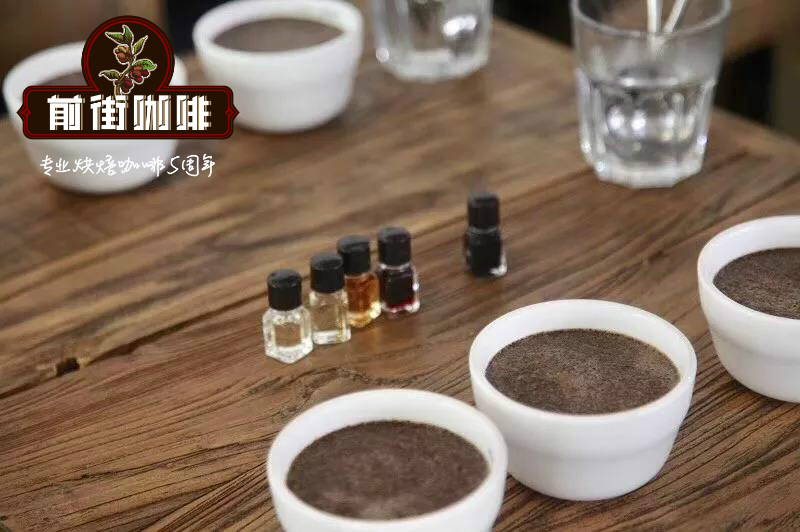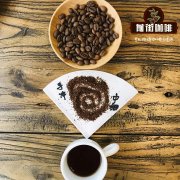Do different varieties of coffee have the same flavor? How to taste the coffee flavor

Professional coffee knowledge exchange more coffee bean information please follow the coffee workshop (Wechat official account cafe_style)
I believe that many enthusiasts will encounter such a situation. I buy a bag of beans with citrus and peach flavor, but I can't taste them, so I suspect it's the beans, the cooking, or the senses.
The problem of coffee flavor bothers many students. How can I not drink so many flavors on the flavor table? ~ after all, not everyone has a professional feeling, or I drink not peach flavor, but plum flavor. The reason for this difference is the difference in cultural life, diet, region and description of the same cup of coffee, so coffee tasting, the most important thing is communication. Tell me how you feel about this bean, different culture, different experience, different description must be different, but this kind of communication can bring a lot of fun, right?
The aroma of coffee is felt by our sense of smell, and the aroma is definitely thousands of times more complex than the taste. Usually we say that coffee has the taste of apple is actually felt by the nose. There are many descriptions of fruits in the flavor wheel: strawberry, blueberry, raspberry, jasmine, grapefruit, lime, cherry, grape, peach, black tea.
We can smell a smell, taste a taste, but maybe we can't describe it very accurately. The coffee flavor wheel can classify all the taste systems perceived by humans and specifically, corresponding to the smell system is the smell wheel. With practice, the two can clearly perceive the slightest differences among all odors.
When it comes to aroma and taste, this can be said to be the most similar place between coffee and wine. Like wine, coffee has a unique aroma due to the influence of different soils and roasting processes. When it comes to the roasting process, the quality of coffee is equivalent to that of wine brewed in the cellar, and the roasting temperature will affect the quality of the coffee, just as the cellar will affect the final taste of the wine. Coffee tasting is the same as tasting red wine, distinguishing between local customs and varieties, and coffee bean varieties show different flavors in different countries and regions.
Take species as an example, there are many kinds of coffee in every corner of the world. Coffee beans grown in different soils have different aroma and taste. Like grapes, different soil is suitable for different coffee trees, and elements such as soil, sunlight and other climate can affect the aroma, taste and quality of coffee.
Before the entrance, use your nose to appreciate the aroma of the coffee. Here you can not hesitate to borrow wine tasting words, first smell your coffee to see if it has aroma, such as flower, fruit or wine, whether there is abnormal rotten soil, mildew, volatile sour or spicy taste, these are the taste produced by poor quality or improper preservation of coffee beans. If it is a healthy coffee, then in the aroma can give you a lot of enjoyment. You can not hesitate to use the wine tasting system to evaluate a coffee, looking for fruity, floral, botanical, roasted and spicy aromas. As the heat of coffee helps spread the aroma, you can easily capture the rich and complex aroma of coffee.
This paper briefly introduces several common coffee varieties, which have some flavor characteristics in different regions, and can also be used as a reference for the description of coffee flavor terms:
Rose summer variety (Geisha)
Panama (Geisha): strawberry (strawberry), jasmine (jasmine floral), mint (bergamot), caramel (caramelly), chocolate (chocolate), grapefruit (grapefruity), plum (plum), citrus (citrus-orange)
Costa Rica (Geisha): sweet (sweet floral), jasmine (jasmine), citrus (citrus-orange), caramel (caramelly), chocolate (chocolate)
Colombia (Geisha): pomegranate (grave), vanilla (vanilla), chocolate (chocolate), caramel (caramelly), citrus (citrus)
Geisha: lime (lime juice), vanilla (vanilla), jasmine (jasmine floral), sweet grapefruit (sweet grapefruit), rose tea (tea-rose), strawberry (pine-strawberry)
Iron pickup (Typica)
Peru (Typica): nutty (nutty), milk chocolate (milky chocolate), herbs (herbal-floral), pears (pear-fruit), vanilla (vanila), caramel (caramel), apples (apple-like), honey (honey-like), peach tea (peach tea), ripe oranges (ripe orange), jasmine (jasmine hints)
Typica: almond peel (almond skins), silky taste (silky mouthfeel), brilliance (brightness), red malic acid (red apple acidity), roasted peanuts (roasted peanut), hazelnut (hazelnut), orange peel (orange peel), melon (melon), sweet grape juice (sweet spice grape juice)
Typica: Apple (apple), cocoa powder (cocoa powder), caramel (caramel), BlackBerry (black berry), orange white hair (orange pekoe tea), honey (honey)
Mexico (Typica): floral (floral), hazelnut (hazelnut), mango sweet (mango sweetness), peach and apricot (peach-apricot), vanilla (vanila), unripe apple (malic)
Panama (Typica): chocolate (chocolate), apple (apple), peach (peach), plum (plum), floral (floral), caramel malt (caramel-malt), lemon (lemon), buttery taste (buttery mouthfeel)
Costa Rica (Typica): soft chocolate (soft chocolate), honey (honey-candy), apple (apple), weak citrus acid (less citrus acidity), white grape (white grape), orange (tangerine), apple juice (apple juice), nectar (floral honey), hibiscus flower (hibiscus floral)
Bourbon (Bourbon)
Brazil (Bourbon): cocoa powder (cocoa powder), orange (orange), vanilla (vanila), almonds (almond), chocolate (chocolate), caramel (caramelly), yellow sugar (brown-sugar), dried mango (dry mango), peach (peach)
Nicaragua (Bourbon): milk chocolate (milky chocolate), maple syrup (maple syrup), walnut (walnut), peach-apricot aroma (peach-apricot), almond (almond), honey (honey), malt (malty)
Panama (Bourbon): floral (floral), cherry fruits (cherry-fruited), vanilla (vanilla), malt (malty), caramel (caramelly), chocolate (chocolate)
Tanzania (Bourbon): caramel (caramelly), sweet fruit (very sweet fruit), brown sugar (brown sugar), vanilla (vanilla), chocolate (chocolate)
Bourbon: caramel (caramelly), toast (toasted bread), chocolate powder (chocolate powder), apple (apple), plum (plum)
Costa Rica (Bourbon): sugar (sugar sweetness), roasted almonds (roasted almond), hazelnut (hazelnut), peanut (peanut), BlackBerry (black berry), cinnamon (cinnamon), malt (malt), sweet tobacco (sweet tobacco flavor)
Marago Gippe (Maragogype)
Nicaragua (Maragogype): lemon (lemon), cinnamon (cinnamon), cola (cola), floral (floral), citrus (citrus), melon (melon)
Maragogype: strawberries (strawberry), toast (toasted bread), vanilla (vanilla), raisins (raisin), flowers (floral), plums (plum), hibiscus flowers (hibiscus)
Kent (Kent)
India Malabar (Kent): spicy aroma (pungent spicy), tobacco (pipe tabacco), caramel (caramelly)
Pacas (Pacas)
El Salvador (Pacas): sweet peach (sweet peach), vanilla (vanilla), flower (floral), jasmine (jasmine floral), caramel (caramelly), orange (orange), lemon (lemon), melon (melon)
Honduras (Pacas): bergamot (bergamot), Chinese fir (cedar), honey (honey), peach (peach), lemon (lemon), grape (grape), watermelon (watermelon), apple (apple), dried grape (raisin)
Pacamara (Pacamara)
Pacamara: caramel (caramelly), honey (honey), vanilla (vanilla), flower (floral), peach (peach), hazelnut (hazelnut), jasmine (jasmine)
Nicaragua (Pacamara): chocolate (chocolate), caramel (caramelly), orange (orange), maple syrup (maple syrup), honey (honey), raspberry (raspberry), cinnamon (cinnamon), apricot (apricot)
El Salvador (Pacamara): oranges (orange), vanilla (vanilla), lemons (lemon), chocolate (chocolate), apricots (apricot), lemonade (lemonade), limes (lime), flowers (floral)
SL28
Kenya (SL28): malt (malty), caramel (caramelly), almond (almond), flower (floral), vanilla (vanilla), citrus (citrus), apple (apple), peach (peach)
SL34
Kenya (SL34): caramel (caramelly), butterscotch sugar (butter scotch candy), orange (orange), grape (grape), plum (plum)
Catuai (Catuai)
Panama (Catuai): Apple (apple), peach (peach), chocolate (chocolate), apricot (apricot), mango (mango), almond (almond)
Catuai: chocolate (chocolate), cinnamon (cinnamon), plum (plum), honey (honey), lemon (lemon), apple (apple), grape (grape)
Brazil (Catuai): flower (floral), watermelon (watermelon), peach (peach), grapefruit (grapefruity)
Costa Rica (Catuai): pear (pear), floral scent (floral), mango (mango), caramel (caramelly), lemon grass (lemon grass), chocolate (chocolate), Chinese fir (cedar)
Mundo Novo
Brazil (Mundo Novo): nuts (nutty), malt (malty), chocolate (chocolate), banana peel (banana skin), sweet tobacco (sweet tobacco), orange / orange (tangerine/orange)
In fact, as long as we drink more different varieties of coffee, learn more about coffee knowledge, and then practice and communicate repeatedly, it will be easy to drink one or two flavors!
Related recommendations: consciously taste coffee: the correct use of SCAA coffee flavor wheel and tips
Important Notice :
前街咖啡 FrontStreet Coffee has moved to new addredd:
FrontStreet Coffee Address: 315,Donghua East Road,GuangZhou
Tel:020 38364473
- Prev

How to Make Coffee Without Bitterness
Professional coffee knowledge exchange More coffee bean information Please pay attention to coffee workshop (Weixin Official Accounts cafe_style) Coffee bitter? So sour? When many people come into contact with coffee, bitter is strong, strong is fragrant, meet such guests we will patiently explain, coffee flavor what, strong is not necessarily fragrant, bitter is not necessarily, but for a never study coffee
- Next

What is coffee body? Teach you how to correctly describe the flavor of coffee
Professional coffee knowledge exchange more information about coffee beans Please follow the coffee workshop (Wechat official account cafe_style) for coffee, body seems to be the most difficult term to understand. When we describe the human body, we mean the human body and posture; but body seems to be completely different, because the word used to describe body is more confusingly light and thick.
Related
- Beginners will see the "Coffee pull flower" guide!
- What is the difference between ice blog purified milk and ordinary milk coffee?
- Why is the Philippines the largest producer of crops in Liberia?
- For coffee extraction, should the fine powder be retained?
- How does extracted espresso fill pressed powder? How much strength does it take to press the powder?
- How to make jasmine cold extract coffee? Is the jasmine + latte good?
- Will this little toy really make the coffee taste better? How does Lily Drip affect coffee extraction?
- Will the action of slapping the filter cup also affect coffee extraction?
- What's the difference between powder-to-water ratio and powder-to-liquid ratio?
- What is the Ethiopian local species? What does it have to do with Heirloom native species?

